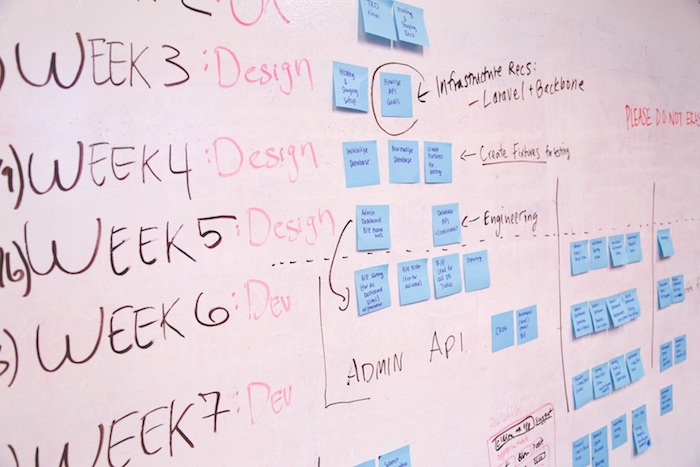Companies around the world increase day by day the number of remote or virtual teams that collaborate on projects. Armed with a laptop and an Internet connection, they can do their jobs from anywhere. Below we share six crucial steps that form the foundation for the future success of your project, based on experience collected from our 100% remote teams and how our closest clients operate. .
Hire the right people
The first step in developing and managing a successful remote team is having the right people aboard. Apart from the specific requirements for the candidate, what's most important is being responsible and having the capacity to work independently while still maintaining a team player spirit. Select tech-savvy people so that you can easily keep in touch with them and have the opportunity to create a truly united team.
Ensure understanding of project goals and objectives

Clearly defined goals and objectives are crucial for initiative success. They should be easily visible and traceable. Your team members will be much more motivated if they can see progress toward achieving a common goal. Such tools as Agile boards that present tasks at each stage, with the percentage of completion, as well Agile charts, such as Burn-down or Cumulative flow, provide the team with necessary information. This can also be shown on a Gantt chart, which helps you see how the plan is carried out.
Online tools that allow your team to collaborate, stored documents, and a history of similar past projects (if available) are also necessary. Best would be a tool that holds all the features together, so that your people won't spend time jumping from one tool to another, reporting each part in a dozen different apps, wasting precious time and resources.
Another critical element is having a regular online team meeting, where you sum up your sprints or progress on tasks, share problems and obstacles, and plan how to overcome and solve them together. As a manager, especially if you work with a cross-cultural team, be open for feedback and be sure to engage everyone equally so that no one feels left out. Collect input for their tasks and try to resolve any possible confusion or lack of clarity regarding project milestones, KPIs, or end goals. Take time to address each worker and give him/her the possibility to speak and raise questions. Doing this will help eliminate misunderstanding and even underperformance.
Focus on project outcomes

Set your expectations and have clear KPIs. If a new person joins the team, share with them which outcomes matter, identify their business goals, and explain how they will be rewarded for being successful and exceeding the metrics. If all fields are covered and the action is measurable and defined, they will be more confident to act. You will save time micromanaging them.
One example of how we solve the issue is by setting monthly and quarterly KPIs. In RedmineUP, we establish around 5 points, with importance weighted in the percentage rate of the overall set.
For instance:- [A] Goal: XXX. Weight 20%.
- [B] Goal: YYY. Weight 40%.
- [C] Goal: ZZZ. Weight 15%.
- [D] Goal: VVV. Weight 25%.
Our system automatically tracks the finalization rate of the goal and its share in completing the set.
Communication is the key
Fostering dialogue, building trust, implementing team processes, and utilizing technology are critical for managing remote teams.
Communicate with your team regularly through email, phone, video calls, or online messenger sessions to ensure progress of shared goals and expectations. Track the project's progress regarding implementation of the roles of each employee, deadlines, finances, and customer satisfaction.
Use the knowledge bases, or WIKIs, to store information about your team and organization. It's a great resource for learning new things and finding support for team members. Encourage them to share insights or best practices so that your team can make better decisions and move to another task more quickly than before.
Technology is your best friend

Organize regular video meetings with your team. Skype or FaceTime sessions will unite individuals from different physical locations into a cohesive and coordinated team. Define how and when meetings will be scheduled and who is needed to attend each time.
Use collaboration tools that allow your team to work faster and more efficiently. We used Skype before, but after the recent update, we dropped it, as it often has problems with delivering messages, calls, and synchronization changes between devices.
Now we use Telegram and Telegram groups for communication, as they are much safer, smoother, and better for exchanging information and files. Group admin (manager) can pin a message to the top, so it's always visible. With Telegram bots, it's easy to integrate it with third-party services and set up channels for notifications. With different stickers and gifs, it's also more fun too. :) Some teams prefer to use Slack for communication and as a notification channel.
For our weekly calls, we use FaceTime, as the video and voice quality are much better than what is provided by Skype. It also allows for screen sharing.
Another point as mentioned before is using a visual Agile board for tracking tasks, where you can see current status, comments, and edit checklists on the board.
Set up processes and describe procedures

Proper procedures are essential for running operations in a clear, transparent way that is understandable for each team member. They help when your team or company grows and you scale up operations.
The documentation gives you an excellent foundation to find bottlenecks and fields for optimization and possible automation. In RedmineUP, our development process is well documented and supported by a vast knowledge base and WIKI. This allows new team members to get to work right away and catch up with how we work and our culture. We have described our software development process in another blog article, here.
If your team members are repeating an activity more than twice and it's highly probable that it will happen a third time, you have a foundation for a repeatable process. Describe the procedure to be able to include another person and ensure a smoother onboarding process. In case a team member is replaced by someone else, that person has accessible information and can get to work faster.
Establish a procedure how work will be managed and information shared, reviewed, and modified through secured software. Give user permissions to team members according to their positions and work obligations in the company.
How do you manage the remote team? Which rules would you add?


